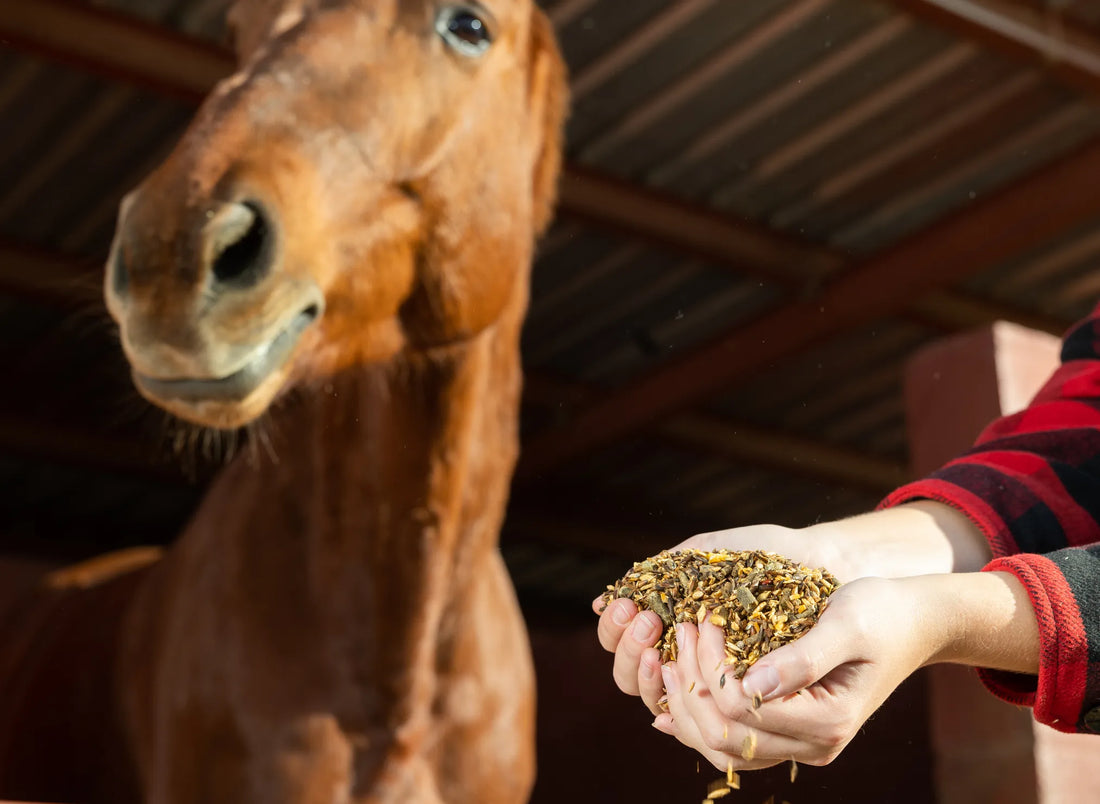
Tips for Safe and Easy Horse Medication Administration
Share
Administering medication to a horse can be a challenging task, especially when the medication has an unpleasant taste. Medication may come in pill, powder, or liquid form. Some horses quickly reject anything unusual in their feed. However, with a little creativity and patience, you can find a method that works best for your horse.
Mixing Medication with Feed
The best way to encourage a horse to take its medication is by mixing it with their favorite feed. Many horses will readily accept medication when it’s hidden in something tasty, such as applesauce, molasses, or soaked beet pulp. Some owners find success by blending medication into a bran mash or yogurt, creating a flavorful disguise. The key is to ensure that the horse consumes the full portion so they receive the entire dose.
I initially tried this method with my senior Quarter Horse mare, Lucky. She was diagnosed with PPID and absolutely hated that little pink pill. I thought hiding it in her grain would be the simplest solution. Instead, she went on a three month-long hunger strike, refusing to touch her feed at all. Some horses, like mine, can be especially suspicious of changes in their food, making alternative methods necessary.

Hiding Pills in Treats
Another strategy is to hide pills in treats. Hollowed-out apples or carrots serve as natural pill pockets. They allow the medication to be concealed within something the horse already enjoys. Soft treats or marshmallows can also be used to wrap around pills, making them easier to ingest.
If the pill is too large, break it into smaller pieces. Alternatively, crush it into a powder to make it more manageable. A pill crusher can be useful for this, ensuring that the medication blends smoothly into a feed mix or treat.
I once tried hiding my mare’s pill in an apple. I thought it was a foolproof trick. However, after one try, she never ate apples again. This method can be very effective for some horses. However, if they figure out the trick and develop an aversion, switching to another treat or method may be necessary.
Using a Syringe for Direct Administration
For those horses who are too clever to fall for hidden medication in their food, using a syringe may be a more reliable method. By mixing crushed pills or powders with a small amount of water, applesauce, or honey, you can create a paste that can be easily administered directly into the horse’s mouth. Positioning the syringe correctly is important—aiming for the back of the tongue helps prevent spit-outs. Rewarding the horse afterward with a favorite treat or scratch can also reinforce positive behavior, making future doses easier to administer.
After many frustrating attempts to hide my mare’s medication in her feed, I turned to this method. However, it wasn’t just the taste she objected to—the act of giving the medication became a battle. She would toss her head, back away, and refuse to cooperate. That’s when I realized timing and training would be just as important as the method itself.
Administering Medication to Horses with Special Diets
For horses with metabolic disorders such as Equine Cushing’s Disease (PPID) or insulin resistance, maintaining a low non-structural carbohydrate (NSC) diet is crucial. This can make medication administration more difficult, as many common disguises like molasses or sweetened feeds are unsuitable. Instead, options such as unsweetened applesauce, soaked timothy or alfalfa pellets, or sugar-free electrolyte pastes can be useful for mixing medication. Additionally, some horses tolerate medication better when mixed with plain yogurt or coconut oil, which can help with palatability while keeping sugar intake minimal.
Training for Medication Acceptance
Training your horse to accept medication willingly can be a game-changer. Practicing with flavored water in a syringe before introducing real medication can help them become more comfortable with the process. Gradually exposing them to different flavors in their diet can also help make them less suspicious when a new taste is introduced. Positive reinforcement, whether through treats, scratches, or verbal praise, can build trust and cooperation over time.
With my mare, I found that slowly desensitizing her to the syringe and rewarding her for positive behavior helped tremendously. Instead of forcing the medication on her, I introduced the syringe with something she enjoyed, like applesauce, and gave plenty of praise. Over time, she became more accepting, and the process became far less stressful for both of us. While it wasn’t an easy road, persistence and adaptation eventually helped me medicate her consistently.
Adjusting Feeding Schedules
Feeding schedules can also play a role in medication success. Horses that receive a large meal before their medication may leave behind the medicated portions. Offering a small amount of unmedicated food first can increase their appetite, making them more likely to consume a medicated mixture. Additionally, providing a highly palatable mix before their full meal can encourage them to eat the entire portion.
Consulting a Veterinarian for Alternative Solutions
If you continue to struggle with administering medication, consulting your veterinarian can provide alternative solutions. Some medications may be available in flavored formulations, injections, or compounded versions that make them easier to give. Never alter the form of a medication without veterinary approval, as some medications are not safe to crush or dissolve.
Final Thoughts
Finding the best approach for your horse may require a bit of trial and error, but with patience and persistence, medication time can become a stress-free experience for both you and your horse. My experience with my mare was frustrating at times, but it ultimately taught me that every horse is different and that finding the right method takes time. By using a combination of taste-masking techniques, direct administration, and positive reinforcement, you can ensure your horse gets the treatment they need while maintaining their trust and well-being.
